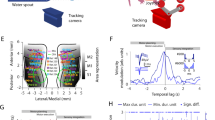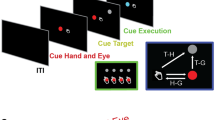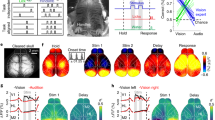Abstract
That animals and humans can accomplish the same goal using different effectors and different goals using the same effectors attests to the remarkable flexibility of the central nervous system. This phenomenon has been termed ‘motor equivalence’1,2, an example being the writing of a name with a pencil held between the toes or teeth. The idea of motor equivalence has reappeared because single-cell studies in monkeys have shown that parameters of voluntary movement (such as direction) may be specified in the brain, relegating muscle activation to spinal interneuronal systems3,4. Using a novel experimental paradigm5 and a full-head SQUID (for superconducting quantum interference device) array to record magnetic fields corresponding to ongoing brain activity, we demonstrate: (1), a robust relationship between time-dependent activity in sensorimotor cortex and movement velocity, independent of explicit task requirements; and (2) neural activations that are specific to task demands alone. It appears, therefore, that signatures of motor equivalence in humans may be found in dynamic patterns of cortical activity.
This is a preview of subscription content, access via your institution
Access options
Subscribe to this journal
Receive 51 print issues and online access
$199.00 per year
only $3.90 per issue
Buy this article
- Purchase on Springer Link
- Instant access to full article PDF
Prices may be subject to local taxes which are calculated during checkout





Similar content being viewed by others
References
Lashley, K. S. Basic neural mechanisms in behavior. Psychol. Rev. 37, 1–24 (1930).
Hebb, D. O. The Organization of Behavior: A Neuropsychological Theory (Wiley, New York, 1949).
Bizzi, E., Mussa-Ivaldi, F. & Giszter, S. Computations underlying the execution of movement: a biological perspective. Science 253, 287–291 (1991).
Georgopoulos, A. P. Neural networks and motor control. Neuroscientist 3, 52–60 (1997).
Kelso, J. A. S., DelColle, J. D. & Schöner, G. in Attention and Performance XIII (ed. Jeannerod, M.) 139–169 (Erlbaum, Hillsdale, New Jersey, 1990).
Romani, G. L. in Advances in Biomagnetism (eds Williamson, S. J., Hoke, M., Stroink, G. & Kotani, M.) 33–46 (Plenum, New York, 1989).
Fuchs, A., Kelso, J. A. S. & Haken, H. Phase transitions in the human brain: spatial mode dynamics. Int. J. Bifurc. Chaos 2, 917–939 (1992).
Uhl, C., Friedrich, R. & Haken, H. Analysis of spatiotemporal signals of complex systems. Phys. Rev. E 51, 3890–3900 (1995).
Kelso, J. A. S. et al. Aphase transition in human brain and behavior. Phys. Lett. A 169, 134–144 (1992).
Cheyne, D. & Weinberg, H. Neuromagnetic fields accompanying unilateral finger movements: pre-movement and movement-evoked fields. Exp. Brain Res. 78, 604–612 (1989).
Kristeva, R., Cheyne, D. & Deecke, L. Neuromagnetic fields accompanying unilateral and bilateral voluntary movements: topography and analysis of cortical sources. Electroencephalogr. Clin. Neurophysiol. 81, 284–298 (1991).
Wiesendanger, M. & Miles, T. S. Ascending pathway of low-threshold muscle afferents to the cerebral cortex and its possible role in motor control. Physiol. Rev. 62, 1234–1270 (1982).
Georgopoulos, A. P., Kalaska, J. F., Caminiti, R. & Massey, J. T. On the relations between the direction of two-dimensional arm movements and cell discharge in primate motor cortex. J. Neurosci. 2, 1527–1537 (1982).
Schwartz, A. B., Kettner, R. E. & Georgopoulos, A. P. Primate motor cortex and free arm movements to visual targets in three dimensional space. I. Relations between cell discharge and direction of movement. J. Neurosci. 8, 2913–2927 (1988).
Moran, D. W. & Schwartz, A. B. Motor cortical representation of speed and direction during reaching. J. Neurophysiol. (in the press).
Bartlett, N. R. & Bartlett, S. C. Synchronization of a motor response with an anticipated sensory event. Psychol. Rev. 66, 203–218 (1959).
Wing, A. M. & Kristofferson, A. B. The timing of interresponse intervals. Percept. Psychophys. 13, 455–460 (1973).
Dunlap, K. Reactions to rhythmic stimuli. Psychol. Rev. 17, 399–416 (1910).
Acknowledgements
This research was supported by NIMH (U.S.A.), NSERC (Canada) and the Human Frontier Sciences Program. We thank M. Burbank and J. Vrba for the use of facilities at Port Coquitlam, British Columbia.
Author information
Authors and Affiliations
Corresponding author
Rights and permissions
About this article
Cite this article
Kelso, J., Fuchs, A., Lancaster, R. et al. Dynamic cortical activity in the human brain reveals motor equivalence. Nature 392, 814–818 (1998). https://doi.org/10.1038/33922
Received:
Accepted:
Published:
Issue Date:
DOI: https://doi.org/10.1038/33922
This article is cited by
-
Multiple levels of contextual influence on action-based timing behavior and cortical activation
Scientific Reports (2023)
-
Causation and cognition: an epistemic approach
Synthese (2021)
-
Large-scale brain modes reorganize between infant sleep states and carry prognostic information for preterms
Nature Communications (2019)
-
Controlling the thermoelectric effect by mechanical manipulation of the electron’s quantum phase in atomic junctions
Scientific Reports (2017)
-
Kinematics in the brain: unmasking motor control strategies?
Experimental Brain Research (2017)
Comments
By submitting a comment you agree to abide by our Terms and Community Guidelines. If you find something abusive or that does not comply with our terms or guidelines please flag it as inappropriate.



